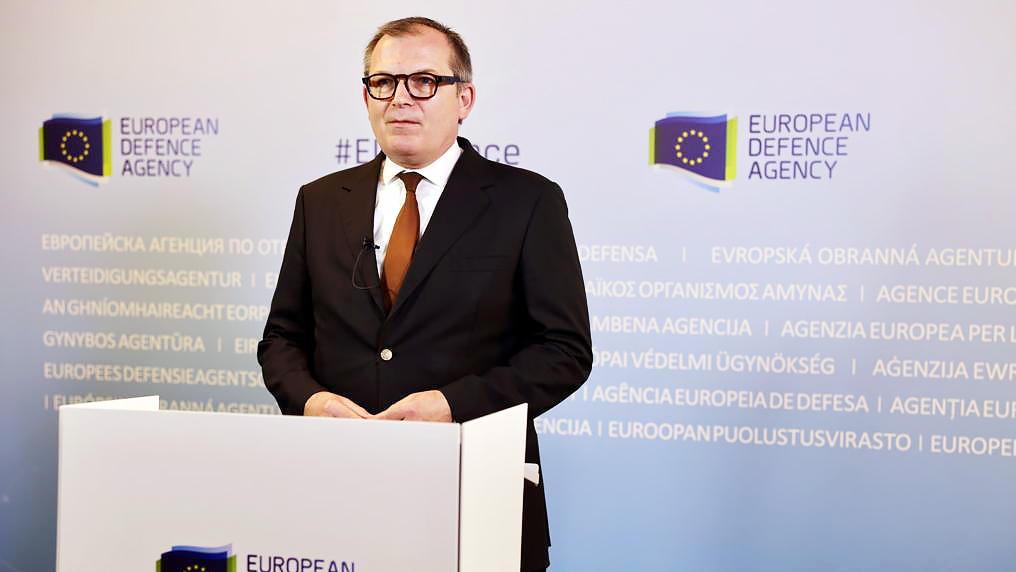At a high-level online conference co-hosted today by the European Defence Agency and the Portuguese Ministry of Defence (under the auspices of the current Portuguese EU Presidency), senior representatives from Ministries of Defence, defence research centres, industry, European institutions as well as NATO discussed existing and future challenges and opportunities related to emerging disruptive technologies in defence.
Emerging disruptive technologies (EDTs) such as artificial intelligence, big data, quantum technology, robotics, autonomous systems, new advanced materials, blockchain, hypersonic weapons systems and biotechnologies applied to human enhancements - to name only them - are expected to have a disruptive impact on defence and revolutionise future military capabilities, strategy and operations. The conference provided a comprehensive overview of EDA’s role in European defence research and stressed the need for Member States and the EU to sustain and further increase investment in innovative and disruptive technologies to support state-of-the-art defence capabilities.
The event was opened by the Portuguese Minister of Defence, João Gomes Cravinho (speaking from Porto) and EDA Chief Executive Jiří Šedivý.
In his speech, Minister Cravinho stressed the need for cooperation and synergies between civil and military actors in order to get the most out of new emerging technologies for defence. “When it comes to EDTs, we need to stimulate synergies between NATO, the European Commission and EDA, taking advantage of civil-military cooperation and the dual-use nature of technological development”, he stated.
EDA Chief Executive Šedivý said in his speech that the EU’s strategic and political defence ambitions can only be credible if they are underpinned by technology and innovation. “For the EU to be a credible security provider and a trusted partner in defence, we must focus our efforts on the development and mastering of technologies that have a serious potential to revolutionise our military capabilities, strategies and operations. Emerging Disruptive Technologies, such as Artificial Intelligence, quantum technologies or hypersonic weapons and new space technologies, must be in the centre of our capability development”, he stated.
 |
| Jiří šedivý, EDA Chief Executive |
Disruptive technologies for disruptive capabilities
The opening part was followed by several keynote speeches.
Focusing on the disruptive potential of technologies at the interface between security, defence and space, Stephen Quest (European Commission Director at the General Joint Research Centre) said the strategic importance of cross-fertilisation between civil-military industries was behind the Action Plan the European Commission has presented last February to enhance synergies and cross-fertilisation between civil, defence and space industries. The Action Plan covers three priorities, Mr Quest said. “First, to build new synergies among EU programmes and instruments so that disruptive technologies can find concrete uses across civil, defence and space industries. Secondly, to enable that defence and space technologies find concrete civil applications, the so-called ‘spin-offs’. And thirdly, to facilitate the use of civil research and innovations into new European defence projects, the so-called ‘spin-ins’”. The Commission will present by October a roadmap on key technologies for security and defence including options for (a) boosting research, development and innovation and (b) reducing strategic dependencies in critical technologies and value chains, he said.
General André Lanata, NATO’s Supreme Allied Commander, said EDTs were technologies whose practical uses have the potential to fundamentally change the way military forces operate. If we are serious about seizing the opportunities of EDTs, we need to fundamentally change the way we operate and think. We need resources and above all a cultural revolution, he stated. Innovation and EDTs offer a wide range of opportunities for fruitful boosts to EU-NATO cooperation, he added.
Petter Bedoire (Chief Technology Officer, Saab Group) referred to the need to make sure the new technologies developed will create opportunities rather than threats. There is also the challenge of finding a balance between the possibilities enabled by disruptive technologies and the defence capabilities actually required by the Armed Forces, he said.
Panel discussions
Throughout the day, the conference attendants witnessed three successive panel discussions:
- The first one on Disruptive Technologies and the Expected Impact on Defence with the following panellists: MGen Corte-Real Andrade (R&T Director, MoD Portugal), Jean-François Ripoche (EDA RTI Director), Sylvia Kainz-Huber (Head of Unit, DG DEFIS, European Commission), MGen Herminio Maio (MPCC Chief of Staff), Pablo Gonzales (Chairman of ASD DRDT Working Group and Director NATO & EU Defence Programmes, Indra).
- The second one focused more specifically on Artificial Intelligence with an interesting exchange of views between the panellists Auke Venema (R&T Director, MoD The Netherlands), Alípio Jorge (Coordinator for the national strategy for AI, Portugal), Jonas Andrulis (CEO Aleph, Alpha GmbH), Anna-Mari Heikkila (VTT Finland) as well as Panagiotis Kikiras (EDA Head of Unit Innovative Research).
- The third one, centred on Autonomous Systems, featured Mr Martin Jõesaar (Chief of Project Office at the Estonian Centre for Defence Investments), José Santos Victor (Director of Instituto de Sistemas e Robótica, Portugal), Joachim Schaper (Head of AI and Big Data at Porsche), Paolo Arrighi (Chief Technology Officer - Land Armaments and Systems, Leonardo), Mário Martinho (EDA CapTech Ground Systems moderator).
The conference was closed by Vasco Hilario (National Armaments Director, Portugal) and EDA RTI Director Jean-François Ripoche.
Digital exhibition
Conference participants were also able to visit a digital exhibition of EDA research and technology activities, showcasing a number of Member States successful cooperation projects.
More information